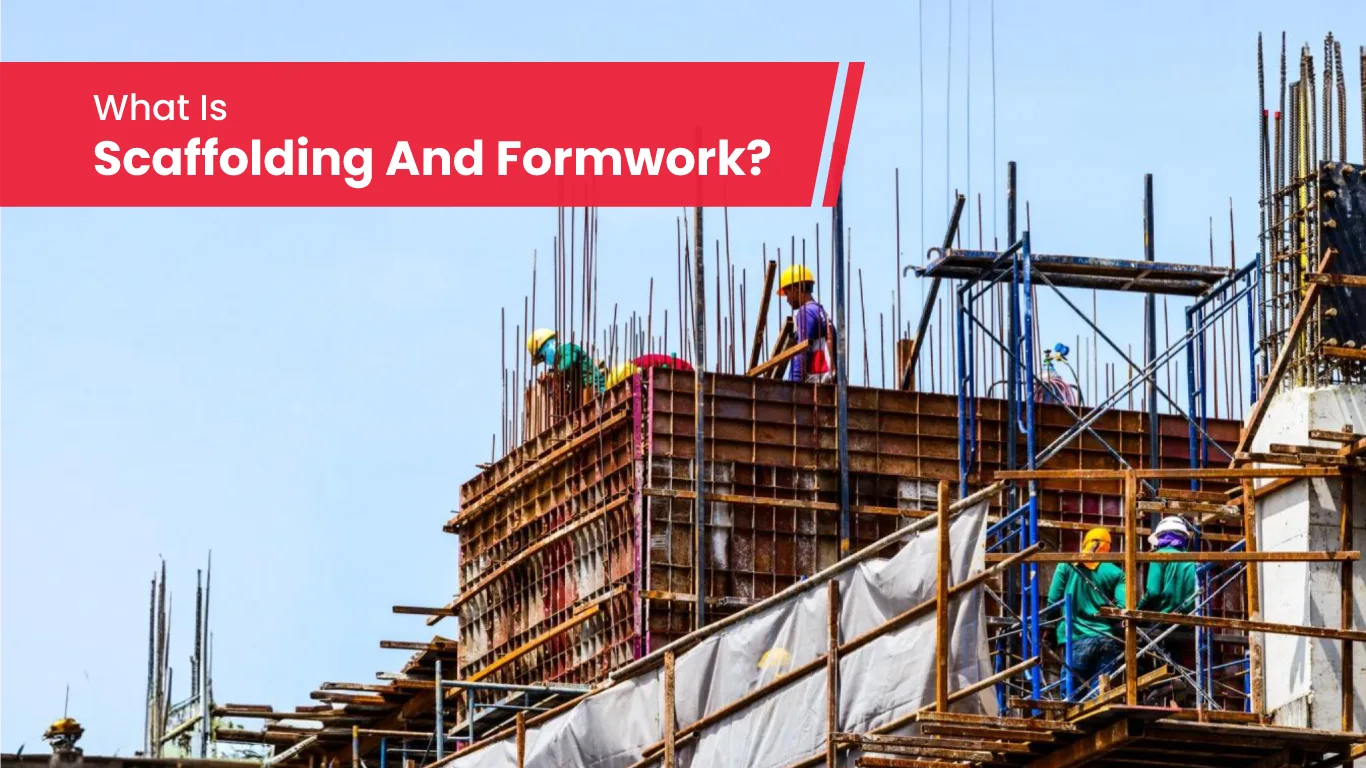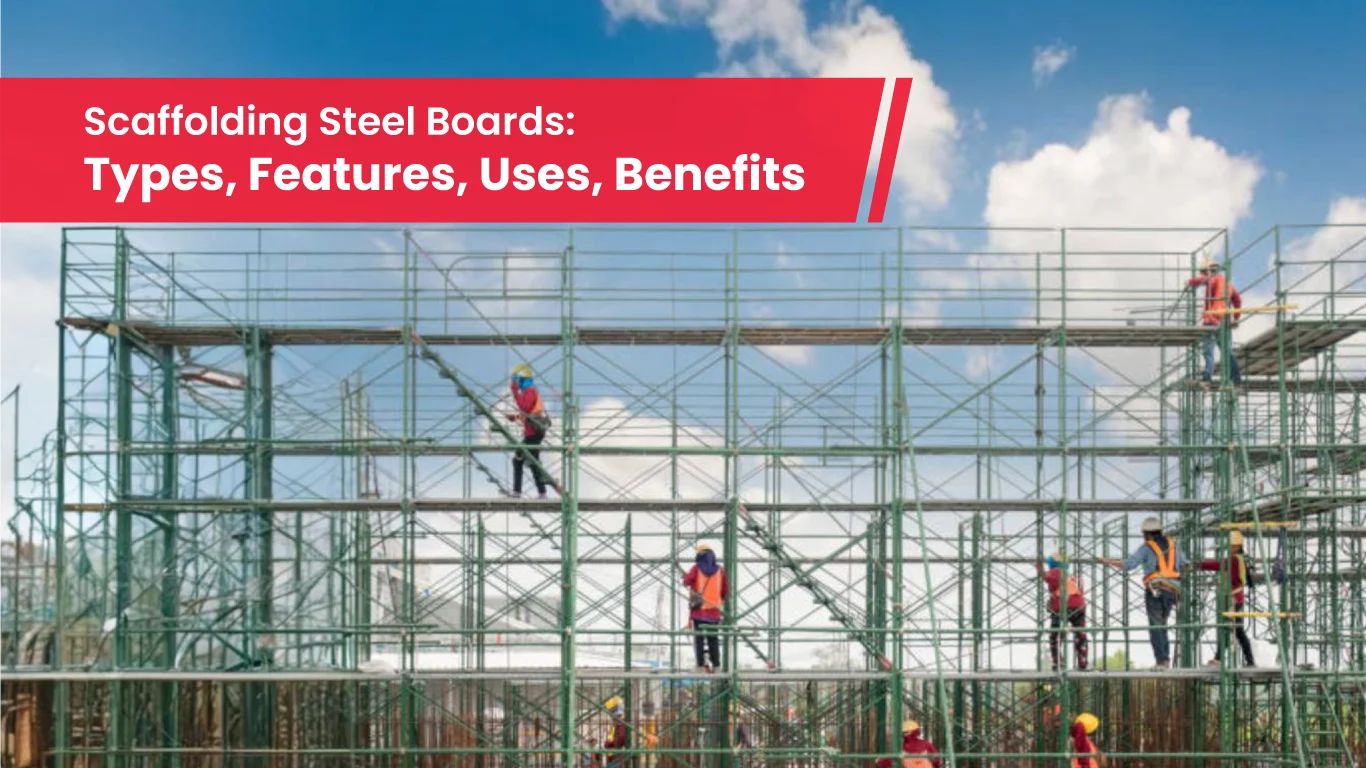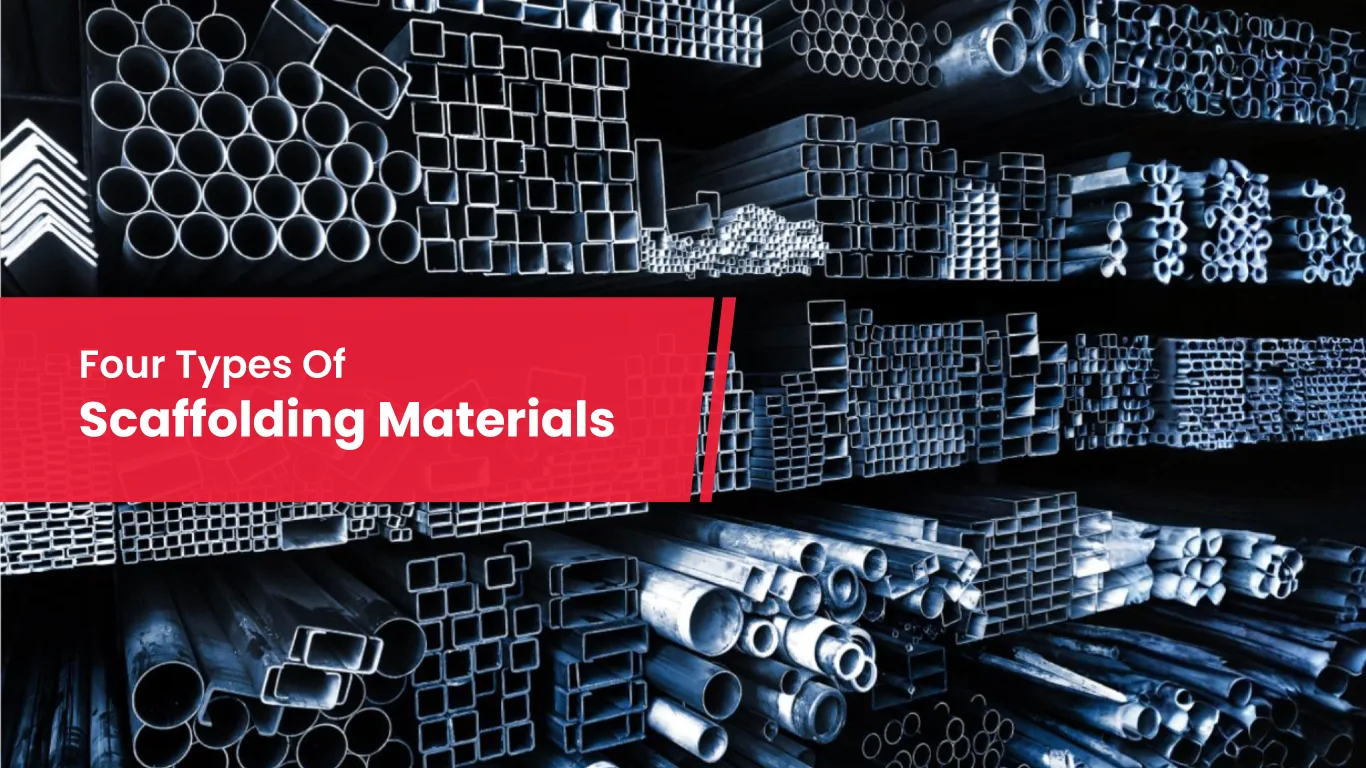What is scaffolding and formwork?
Comments Off on What is scaffolding and formwork?
While working on a construction project, you may have come across scaffolding and formwork. These are known to be temporary structures used in the industry. Once workers set up these structures, they can carry out tasks efficiently. But are you actually aware of scaffolding and formwork? Let’s explore these topics further in this article.
What is scaffolding?
In the construction domain, scaffolding is a component that serves as a temporary structure. Once erected, it provides support during the construction of the building. They may also use the scaffold structure when the building is undergoing renovation. Usually, these are made from wood or metal. It also offers a stable platform for access to elevated areas. As soon as workers use the scaffolding, they can lay bricks, paint the exterior, and carry out many tasks. However, workers must verify the proper design of the structure to ensure safety. If they need to build scaffolds for different projects, then a modular scaffold can be useful.
What is Formwork?
When workers use scaffolding formwork during the construction phase, it serves as temporary mold. This structure helps support concrete until it sets. Soon after pouring the concrete, it hardens in the formwork. But, before using a formwork, workers check its size and capacity to hold liquid concrete. A meticulously designed formwork can enhance structural integrity. Moreover, workers tend to use formwork due to its adaptability. You can use these to form intricate architectural features or simple slabs.
Types of Scaffolding
At a construction site, you will come across many types of scaffolding. Once you source different components from a well-known scaffolding equipment supplier, you can build these structures.
Cuplock Scaffolding
This type of scaffolding is safe to use because of the locking mechanisms. Primarily, such a structure has vertical standards built from high-quality steel. At a specific distance, 500 mm cups connect these standards. Additionally, workers assemble horizontal ledgers using ledger blades. Workers typically use these scaffolds when they lack the time for assembly. The modular design also offers flexibility when workers have to set a configuration for the project. Different kinds of construction projects use the structure due to its stability.
Tubular Scaffolding
Tubular scaffolds can be an alternative to wood scaffolds. These are quite adaptable when there’s a need for a temporary support system. As workers start building this scaffold, they use clamps to connect diagonal braces and horizontal tubes. Furthermore, they can adjust the framework to suit different building shapes. This flexibility in configuration enables efficient access to different areas at the site. Because of its strength and durability, such a scaffold also provides necessary support for workers even when they are using tools.
Ringlock Scaffolding
The design and efficiency of ringlock scaffolding set it apart from other scaffolds. While workers use the structure, they connect vertical and horizontal bars with a ring-shaped locking mechanism. Generally, the socket is 10 mm thick and 122 mm in diameter. Additionally, it features 8 welded holes spaced 500 mm apart. Because the structure is strong, it provides stability, making it suitable for a variety of construction projects. We recommend using this structure when professionals are seeking an adaptable and reliable scaffolding solution.
H Frame Scaffolding
In comparison with other scaffoldings, an H-frame scaffold creates a stable structure. Horizontal crossbars and vertical uprights allow for the erection of the entire scaffold. The best part is that there are no loose fittings throughout the structure. Workers also don’t have to use any tools to erect the scaffold. Because the structure is robust, it remains stable, reducing the risk of sudden accidents. The ease of assembly and dismantling of the structure enables workers to set it up quickly. The workers can then use their time efficiently while carrying out various tasks.
Types of Formwork
The construction sector uses various types of scaffolding formwork to support concrete until it solidifies. Let’s check out the types of formwork.
Steel Formwork
Such formworks are known for their durability and strength, making them ideal for different concrete shapes. Construction projects can also reuse a steel formwork multiple times. While workers use this formwork, they fasten large steel plates with couplings and bars. Furthermore, the formwork is ideal for large-scale projects and reduces the need to carry out finishing work.
Aluminium Formwork
Workers use these forms whenever they need to create a concrete framework. Even though this formwork is lightweight, it is suitable for bearing the weight of a large quantity of concrete. You may also come across this formwork. Workers also use it for repetitive construction tasks due to its ease of assembly. The formwork is also useful when people have to perform tasks efficiently while constructing tall buildings.
Timber Formwork
When you encounter scaffolding formwork, it refers to wooden structures that are used to mold concrete. Such forms are known for their versatility and cost-effectiveness. Therefore, they find widespread application in small-scale projects. However, they can also serve large-scale projects that require intricate designs. They are not only adjustable but also reusable during different phases. Way ahead, workers have to maintain the forms and handle them with great care. If workers misuse them, they may undergo deformation during the curing process.
Plywood Formwork
If you choose to use plywood scaffolding formworks, they are durable and have no negative environmental impact. Workers can also expect high-quality solidified concrete after using such formwork. These are usually made by placing different layers one over the other. But, even when it’s simple to assemble and dismantle the formwork, people should ensure stability. We also need to take action to prevent it from deteriorating during the concrete curing process.
Conclusion
Finally, you should consider scaffolding and formwork depending on the project’s needs. While you confirm your choice of scaffolding, check for its load-bearing capacity. However, when selecting a formwork, ensure it is reusable and easily adjustable. The chosen formwork and scaffold should also meet local safety standards.
Are you looking for a reliable scaffolding equipment supplier for your project? Well, how about connecting with AAIT scaffolds? While our team understands your requirements, we are flexible in distributing scaffolds throughout the United States. Using a strategic approach, our team ensures the delivery of scaffolding within the specified time frame. In addition, we assure quality for every kind of component.
Scaffolding Steel Boards: Types, Features, Uses, Benefits
Comments Off on Scaffolding Steel Boards: Types, Features, Uses, Benefits
Whenever you’re managing a construction project, many scaffold components can be useful. As workers erect the structure, they can also place scaffolding steel boards. These provide a surface on which people can stand. Furthermore, the design of these boards incorporates pre- galvanized steel, ensuring their durability. Designed with OSHA standards in mind, these boards offer numerous benefits over conventional ones. Workers can also replace such boards because different hooks are present. But even when such boards are available in different sizes, they suit certain applications. Therefore, in this article, we will delve deeper into the various types of scaffolding steel boards.
Types of scaffolding steel boards
There are numerous types of scaffolding boards available in the market. But the boards are generally classified depending on the material, design, and finish.
Types of Scaffolding Boards by Material
You can design scaffolding boards from either wood or metal. These are the types of boards.
Scaffolding wooden boards
As manufacturers make wooden boards, they ensure that they have six rings across every inch. Manufacturers refer to boards made from Douglas Fir or pine trees as solid-sawn boards. On the other hand, manufacturers may also think about integrating thin wooden layers using durable adhesive. These are known as laminate veneer lumber boards.
Scaffolding Metal Boards
Under this category, you will observe the boards made from steel or aluminum. While steel boards have excellent load-bearing capacity, the aluminum ones are light in weight. Moreover, steel boards last longer than the ones made from aluminum.
The various types of scaffolding steel boards are determined by their design.
You can also classify scaffolding boards based on their designs. If you come across a single steel board, then workers use it for standing while laying bricks. However, people may prefer using double steel boards when they are building structures with stones. People typically arrange these boards in two rows to strengthen the platform. On the other hand, we place single boards parallel to the wall at a distance of 1.2 meters. If you’re looking for long-lasting scaffold components, then contact an experienced scaffolding equipment supplier.
The types of scaffolding steel boards vary based on their hooks and finishes.
In addition to the boards stated above, manufacturers may also develop steel boards with or without hooks. Typically, boards without hooks measure 225 mm in width and 6 m in length. In contrast, hooks are 225 mm in width and have a standard length. Way ahead, painted steel or pre-galvanized steel boards might also be available in the market.
Features of Scaffolding Steel Boards
Scaffold steel boards have a variety of features and are designed for durability and safety. Here are some of its features.
When workers are not using the scaffolding structure, they can easily dismantle these boards.
As workers think about replacing the old scaffold boards, they can use the existing fittings once again. It’s actually not necessary to buy new fittings for replacement.
Such types of boards have reinforced edges. These help to prevent materials and tools from falling sideways.
Scaffolding boards made from steel are suitable for all kinds of modular systems. Additionally, they undergo galvanization to guard against corrosion from chemicals or water.
Many steel boards have a non-slippery surface, which reduces the chance of slipping. Workers can therefore use these boards even when they are wet or oily.
We designed the boards to support a variety of loads. This may include the weight of workers and equipment, as well as the dynamic loads.
Steel boards consistently prioritize durability in their design. As a result, they are more resistant to forces and damage than any other material.
Why use steel scaffolding boards?
Scaffolding steel boards serve a variety of purposes. Here’s why workers should consider such boards.
Saves Money
Wooden boards, which are resistant to fire, last for 3 years. After that, they require replacement. However, even with frequent use, steel boards can endure up to 15 years. It’s actually worth using such boards when workers are erecting a temporary structure.
Reduces the instances of replacements
When your team switches to wooden boards, they require annual replacements. However, using steel boards can reduce the replacement rate by 500%.
Dismantling requires less time.
Upon observing the steel boards, you’ll notice that they feature tube fittings. These will also be safer and disassembled faster.
It helps to reduce the risks of accidents and falls.
Scaffolding steel boards reduce the risk of accidents due to their non slippery surface. Even when the surface gets moist, a non-slip coating can further improve traction.
Remains dry after snow falls or rains
Water drains down through the holes across the steel board’s surface. People don’t have to set aside time to sweep the boards or turn them upside down.
How to Use and Apply Scaffolding Steel Boards
Scaffold steel boards are one of the main parts of a scaffolding structure. Various industries widely utilize these boards.
As soon as workers place steel boards, they can work by standing on a platform. Therefore, the structure relies on these boards for stability.
Steel typically resists fire, making it suitable for use in a variety of industries. In addition to the construction sector, the petrochemical and oil & gas industries also use the boards.
For tasks related to maintenance, workers prefer setting up galvanized steel boards. Additionally, you may observe these boards during mining and execution of power plant projects.
Benefits of Scaffolding Steel Boards
In construction projects, scaffolding steel boards have always offered many benefits. Let’s check out the benefits of these boards.
Durability
Steel boards are quite durable and can sustain heavy loads. These also stay intact during harsh climatic conditions. So, they are ideal for environments where there’s significant wear and tear.
Strength
Such platforms offer stable support even when many people are working. Once set properly, these ensure safety at the construction site.
Longevity
Due to their resistance to corrosion, steel boards last for a long time. The lifespan of steel boards is significantly longer than that of wooden boards. This mitigates the need for replacing them frequently.
Load Bearing Capacity
Because steel boards support heavy equipment, they are ideal for sustaining high loads. Even when workers are carrying out numerous tasks, they are unlikely to break.
Ease of Installation
Steel boards are usually easier to install. Furthermore, these boards allow for adjustments as the project progresses.
Maintenance
Steel boards need less maintenance. Unlike wood, workers don’t have to apply anything to the board’s surface.
Reusability
The boards are cost-effective due to their versatility for various projects. Workers can also recycle them once they tend to become weak.
Fire Resistance
Steel is one of the materials that is fire-resistant. So, they ensure safety whenever fire-related accidents occur.
Why choose AAIT scaffolding steel boards?
Finally, you can contact AAIT Scaffolding for premium-quality scaffold accessories. As a scaffolding equipment supplier, we have always maintained quality standards. Most of our scaffolding solutions fulfill the needs of diverse industries. You can use these for both construction projects and maintenance-related tasks.
Types of Scaffolding Materials – Scaffolding Components – AAIT Scaffold
Comments Off on Types of Scaffolding Materials – Scaffolding Components – AAIT Scaffold
In today’s construction industry, it’s always crucial to choose the right scaffolding material. This will ensure safety and cost-effectiveness for the project. There are less incidents of accidents when the scaffold is of the right material. But, are you aware about the materials meant for designing scaffold components? Well, if you don’t know anything, then read further.
In this article, we will cover four materials that you can use for the scaffold. As you scroll through, you will also be able to make up your mind on which material to choose.
what material is scaffolding made of?
Scaffolds are usually built with parts of different materials. Let’s check out the materials and how they are different with respect to its properties.
Wood
Since many years, many contractors have been using wood for a scaffolding structure. Among its types, timber is a suitable material for a working platform. Apart from being durable, this kind of wood is light in weight. Timber is also affordable and available in different regions. However, it is not as strong as metal. The wood can’t sustain the weight of many workers at the same time.
Beyond everything else, timber can rot or crack easily depending on the climatic conditions. Hence, many workers don’t prefer using timber in the modern age. On the other hand, bamboo is used to make many scaffolding components. This kind of wood is affordable, and readily accessible. We also suggest not to use wood scaffolding. As the material is obtained from cutting down trees, deforestation can impact the environment. Workers may also fall down suddenly in case the wood bends due to the outdoor climate.
Aluminum
Among the different types of materials, Aluminum is known for its weight. When compared to steel, the metal is quite light. This property makes it suitable for scaffolding that needs to be erected quickly. Moreover, the material is less expensive and it reduces costs related to transportation. As the metal comes in contact with air, it doesn’t corrode due to aluminum oxide on its surface.
Eventually, such a material may not be used when stability is a concern. But, you may observe Aluminum components in suspended scaffolding. Such parts are used because they can be moved with ease from one place to the other. The material is also becoming popular while building pump jacks. Such devices are usually used for obtaining crude oil way below the earth’s surface.
If you have to execute a construction project, contact a reputed scaffolding equipment supplier today.
Steel
When people build scaffolds these days, they prefer using steel components. While these are known for strength, they can withstand heavy loads. Just because it’s quite heavier than aluminum, it sustains rough weather conditions. This means that when people are busy working the structure doesn’t collapse when the climate becomes worse. However, the disadvantage of using a steel scaffold is that it tends to corrode.
Even when steel parts are galvanized, it may corrode or rust to some extent. Due to the material’s weight, steel scaffold components are challenging to carry to another location. People may also have to spend more time erecting a steel scaffold. Disassembling a steel scaffold can also involve many workers. Steel structures can also cause discomfort in extreme weather. So, workers have to consider protective measures before using the structure.
Fiberglass
As the industry evolves, many workers are also using fiberglass scaffold components. But, with time, nobody actually knows about this material. This is because the material is only used for building scaffold tubes. Workers may think about using such parts only when electric cables may cause damage. The parts are reserved for certain circumstances.
In addition to everything, the scaffold parts can also be used when there’s danger due to fire. Nevertheless, contractors may not opt for a fiberglass scaffold. The material is quite expensive than steel. The contractor will have to spend more beyond his imagination when he considers a scaffold. Repairing fiberglass scaffolds can also be expensive. In case a section is damaged, then workers will have to replace the component entirely.
Conclusion
Finally, you have to consider many factors before considering scaffold components. If you’re concerned about the load bearing capacity, then opt for a steel scaffold. Moreover, fiberglass scaffolds are suitable for environments with electrical hazards all around. In the end, you should ensure that the parts are not too heavy. This has to be borne in mind because heavy parts need more effort to assemble and take to another location. Besides, you should check if the scaffold material complies with certain regulatory standards.
Buy Quality Scaffolding Material from AAIT
Are you still seeking a reliable scaffolding equipment supplier? Well, how about getting in touch with AAIT Scaffolds? While we ensure prompt delivery of scaffold components, we also assure you with quality. Ultimately, we never run out of stock because we maintain an inventory at a landscape in Houston, Texas. You can certainly reach our yard because it is near many highways in and around Houston.












 Download
Download